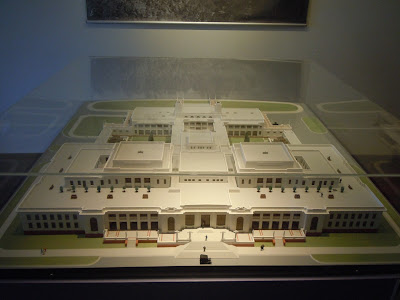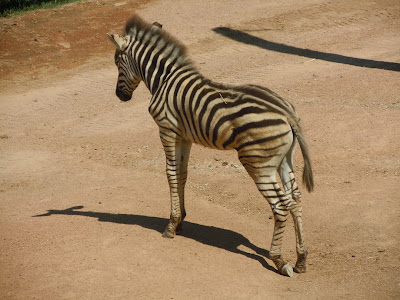Getting out of Melbourne is no easy task. It requires a degree of intrepidity and vehicular legerdemain to avoid finding oneself in the path of a tram. Even with fairly decent maps, it is reasonably difficult to judge when your turn is coming up and, especially in roundabouts, which way you're to turn. The whole looks much easier on a map but when confronted with it in real life, Melbourne traffic proves exceedingly tricky.
I have always thought that Melburnians are the least accomplished drivers in Australia. Although I'm told that the Victorian Police are among the most stringent at enforcing the traffic laws, it seems routine that Melburnians speed and drive as if no laws applied. It is only by good fortune that you negotiate the traffic unscathed. Howsoever hard it may have been, after some harrowing driving through the city, Isabella and I made it to the Hume Highway, the principal route between Melbourne and Sydney.
The Hume is a very interesting highway as highways go as it passes through some fairly scenic terrain and fairly colourful places. To be honest, though, there really isn't all that much between Melbourne and the Victoria-NSW border. The drive was set to be about 6 hours, excluding stops, but we anticipated making Canberra well before nightfall. To pass the time, we turned on the radio but it seemed that every channel was either Christian-based or 30 years behind the times in terms of music. I guess rural Australia hasn't caught up with the rest of the world. It was mildly entertaining though, knowing that some parts of a First World country could be so underdeveloped.
The first place of note we stopped was the town of Glenrowan, just off the main highway. It would be just another small town but for the fact that Australia's most famous outlaw, the bushranger Ned Kelly, and his gang were captured there. In 1880, after terrorizing or fighting for northern Victoria depending on who tells the story, Ned Kelly and the 3 other members of his gang found themselves in Glenrowan. Knowing that the Victorian Police were hot on their trails and coming to Glenrowan by rail, the gang took apart the tracks with a mind to derail the train, thereby killing their pursuers. They then took several hostages and holed everyone up in a local hotel. One of the hostages managed to escape and warned the train of the state of the tracks. The train stopped and the police proceeded unharmed. They set up attack positions near the hotel when Kelly and his gang walked out wearing armour made from steel plows; this has gone down in Australian history as an iconic moment. After a shootout that lasted several hours, the police set fire to the hotel to smoke out the gang. In the interim, Ned Kelly's 3 gang members were killed by gunfire. Eventually Ned himself emerged but was wounded by gunfire. Captured, he stood trial in Melbourne, was convicted and finally hanged. His last ordswere reported to be, "Such is life."
The life of Ned Kelly has made him sort of a folk hero in Australian history. Even today his motives and impact on the Australian psyche are debated. His detractors claim that he was nothing more than a murdering bandit who got what he deserved while his supporters proudly proclaim that he was unjustly vilified, fought for the poor against the government and serves as a symbol of defiance of authority. I think that part of the reason he is still supported is because his adversary was the Victorian Police. Even though they've cleaned up their act in the last few years, the Victorian Police was at one point the focus of major anti-corruption probes, mostly in the 1970s and 1980s. There were massive scandals involving officers taking bribes and doing favours for drug dealers. Combine this with an already heightened mistrust of the police in general and I think it is easy to see why Ned Kelly is so liked in some quarters. People's everyday experience was that it was the cops who were the villains while preaching that they protected the community; the enemy of my enemy is my friend.
Glenrowan makes the most of this notoriety by milking the Ned Kelly legend for all that it is worth. There is a large Ned Kelly statue right on the road into town just off the Hume. There are signs showing where the hotel used to stand and a walk you can do. The small railway station still exists. Everywhere there are wooden posts disguised as either Ned Kelly's gang, police officers or members of the public. The police and gang posts are placed as the participants would have been during the shootout. It's very historically interesting but a little bit gaudy. Isabella and I didn't stay long and after a short stroll around we headed back onto the Hume.
The next important settlements are the twin towns of Wodonga and Albury, collectively called Albury-Wodonga. Their fame lies in the fact that they sit exactly opposite each other on the Murray River which forms the border between Victoria and NSW. Wodonga is in Victoria while Albury, the larger of the 2, is in NSW. I think we stopped for lunch there but there wasn't really any point in stopping there for any longer so we were back on the road in short order.
Just past Albury, the terrain began to take on a familiar feel. The green hills of Victoria now gave way to the yellow, more barren hills of the NSW highlands. This was the terrain of Canberra, though we were still a ways from it.
Along the Hume, we briefly stopped at a town called Holbrook which, very strangely, had a submarine in the middle of town. Apparently Holbrook was named after a famous Australian admiral who happened to be a submariner. In the vein they had the HMAS Otway dismantled and rebuilt, at least the shell, in a park. It seemed like such a strange and surreal thing. You never know what you're going to see in rural Australia.
Continuing on, Isabella and I drove through Gundagai, a small town known for having a sculpture of a dog on a tucker (food) box. Not too far from there, we reached the Barton Highway and from there turned towards Canberra. I should point out that Canberra does not sit on the main highway, the Hume, even though it is the capital. No matter which way you come from, be it Sydney or Melbourne, you have to get off the main highway and take another highway. I think it goes to show the mentality Australians have towards Canberra.
We arrived in Canberra early in the evening and because there wasn't much traffic, I finally conceded to let Isabella drive for a bit. I was a little concerned because it was the opposite to what she is used to in Canada but she handled herself very well. Isabella drove for a short while before deciding that I should take the wheel again. We were quite happy to be in Canberra and I was very anxious to show Isabella the city that I call home.









































